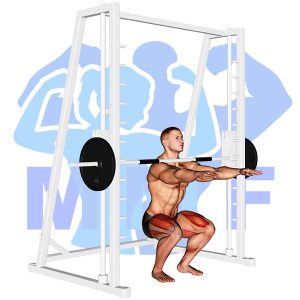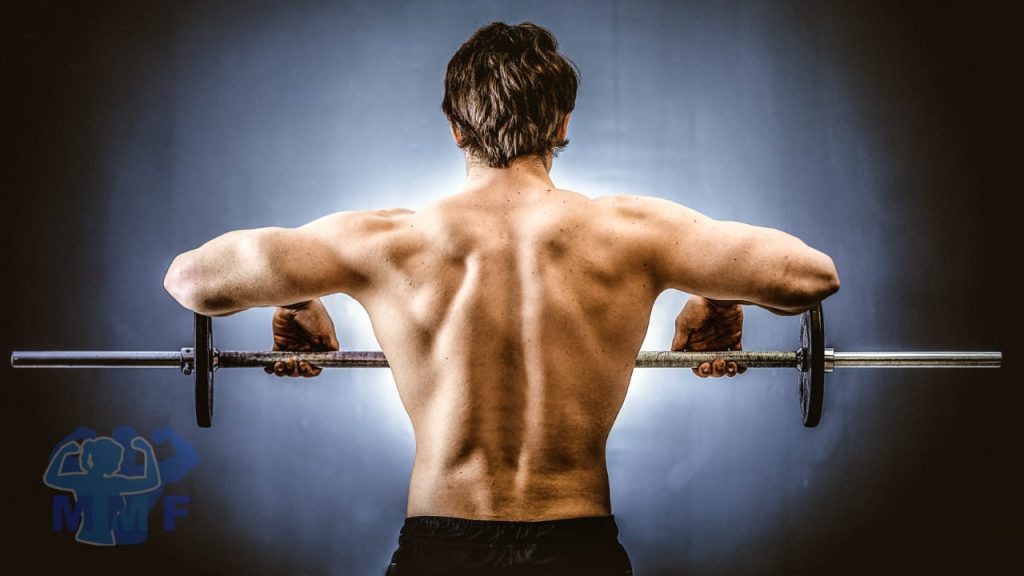Are you looking for a way to improve your squat form and build lower body strength, but struggle with back pain or discomfort? Maybe you’ve tried various squat variations, but none seem to work for you. Don’t worry, you’re not alone. Many lifters face this same challenge, which is why it’s important to find the right squat variation for your needs. The lever squat might just be the solution you’ve been searching for. In this post, we’ll break down the lever squat and how it can benefit your training routine, so you can finally achieve your squatting goals without any discomfort or pain.
Lever Squat (Machine) Summary
- Primary Muscles: Quadriceps
- Secondary Muscles: Adductor Magnus, Gluteus Maximus, and Soleus
- Equipment: Squat Machine
- Mechanics Type: Compound
- Force: Push
- Utility: Basic

Lever Squat (Machine) Instructions
- • Stand with feet hip-width apart.
- Hold a weight in each hand.
- Push your hips back, bending your knees and lowering your body.
- Keep your core tight and your back straight.
- Make sure your knees stay behind your toes.
- Squeeze your glutes and press through your heels to stand up again.
- Repeat for desired number of reps.
Video Tutorial
Lever Squat (Machine) Muscles
Target (Agonist)
Synergists
- Adductor Magnus
- Gluteus Maximus
- Soleus
Dynamic Stabilizers
Stabilizers
- Erector Spinae
- Levator Scapulae
- Trapezius – Middle
- Trapezius – Upper
Antagonist Stabilizers

Benefits of Lever Squat (Machine)
The Lever Squat (Machine) is a great exercise to include in a strength training or fitness routine as it targets the quadriceps muscles and helps to improve lower body strength. The Lever Squat (Machine) works the quadriceps muscle more than any other exercise and helps to increase the size and strength of the muscle. Furthermore, performing this exercise allows for more control over the range of motion and weight used, making it an ideal choice for those just starting out with strength training. Additionally, it reduces the risk of injury since it eliminates the need to balance the weight while squatting. Overall, the Lever Squat (Machine) is an effective exercise for targeting the quadriceps muscles and improving lower body strength.
Tips for Performing Lever Squat (Machine)
Lever Squat is an effective exercise to help you get fit. If you want to make the most of your exercise, try these tips to get the best results and enjoy the benefits that come with it.
- Maintain proper form: To ensure optimal performance and injury prevention, it is important to keep the back straight, chest up and head looking forward throughout the entire exercise.
- Keep weight in the heels: When performing the Lever Squat, focus on keeping the weight in the heels to avoid shifting it forward and putting unnecessary pressure on the knee joint.
- Use a full range of motion: To fully engage the muscles and maximize the results of the Lever Squat, ensure that you are using a full range of motion by lowering your body until your thighs are parallel with the floor and pushing up through the heels to stand back up.
Benefits and Tips Video
Frequent Mistakes To Avoid
It is important to perform Lever Squats correctly in order to maximize the benefits and avoid any potential injury. Before attempting this exercise, take the time to learn the technique and proper form. To ensure you are performing this exercise safely and effectively, be sure to avoid the following mistakes.
- Not keeping the back straight: It is important to ensure that the back is kept straight throughout the exercise in order to prevent any strain on the lower back. The correct posture should be maintained, with the chest lifted, and the shoulder blades retracted.
- Not engaging core muscles: Engaging the core muscles will help to keep the body in proper alignment during the exercise. This will help protect against injury and also ensure that the exercise is properly performed.
- Excessive load: Lever squats can be quite challenging, and it is important to start with a light weight and gradually increase the weight as technique improves. Using too much weight can lead to improper form or even injury.
Find More Machine Exercises Here
Variations and Complementary Exercises
Before we get into the list of variations, complementary, or alternative exercises for Lever Squat (Machine), it is important to understand why you would want to do such exercises. These exercises are designed to target the same muscles as the Lever Squat (Machine), while providing a different stimulus and variety of movements. This can help break up any workout routine and keep things interesting. Additionally, these exercises may be beneficial if you have any injuries or limitations that prevent you from performing the Lever Squat (Machine). Now, let’s take a look at some variations, complementary, or alternative exercises for Lever Squat (Machine).
Prisoner Squat

Prisoner Squat is a great complementary or alternative exercise for Lever Squat (Machine). It is an effective bodyweight exercise that strengthens the same muscle groups, including the glutes, quadriceps, and hamstrings. The main difference is that Prisoner Squat requires more balance, coordination, and core strength as the lifter must maintain proper posture throughout the movement. As a result, the lifter must use more muscles to stabilize their body while performing the exercise. This makes Prisoner Squat a great functional exercise that can help improve overall fitness and athleticism.
Smith Machine Clean Grip Front Squat

The Smith Machine Clean Grip Front Squat is an effective alternative or complementary exercise to the Lever Squat (Machine). Unlike the Lever Squat, the Smith Machine Clean Grip Front Squat puts greater emphasis on the quads and less on the glutes and hamstrings. It also helps to reduce lower back strain by providing more stability than the Lever Squat. The exercise is done with a clean grip on the bar and involves a deep squat that works the quads and core muscles while also strengthening the entire lower body. It is a great choice for those looking to increase their squat strength while reducing the risk of injury.
Smith Machine Frankenstein Squat

The Smith Machine Frankenstein Squat is a great complementary or alternative exercise to the Lever Squat (Machine). This exercise targets the same muscle groups as the Lever Squat, and it is a great way to increase range of motion, stability, and intensity. It also helps to develop balance and coordination by requiring the user to move their body through an entire range of motion. The Smith Machine Frankenstein Squat can be performed in a standing or seated position, and requires more of a focus on keeping the core tight and the back straight. This exercise also helps to target the stabilizing muscles around the hips and thighs, which can help to improve overall squat performance.
Check Out These Top Machine Exercises
Smith Machine Front Squat

The Smith Machine Front Squat is a great alternative or complementary exercise to the Lever Squat (Machine). This exercise works the same muscles and provides the same benefits as the Lever Squat, but requires less balance and stability due to the support of the Smith machine. Unlike the Lever Squat, which requires you to balance the barbell, the Smith Machine Front Squat has a barbell secured in a fixed vertical position that allows you to squat without having to balance the weight. This exercise is great for those who are new to squatting or who have difficulty balancing a barbell. It is also great for those who are looking for a variation of the Lever Squat.
Smith Machine Squat

The Smith Machine Squat is a great complementary or alternative exercise to the Lever Squat (Machine). This exercise, which is performed on a Smith Machine, is similar to the Lever Squat in that it requires you to squat while maintaining a vertical torso. The main difference is that the Smith Machine provides stability and support, which allows you to focus more on form and control. Additionally, the Smith Machine Squat targets the quads more than the Lever Squat and can be a great way to switch up your routine.
Smith Machine Zercher Squat

The Smith Machine Zercher Squat is an effective alternative or complementary exercise to the Lever Squat (Machine). This exercise targets the same muscle groups as the Lever Squat, such as the quadriceps, glutes, and hamstrings. However, the Smith Machine Zercher Squat is a more intense exercise because it requires the weight to be held in the crook of the elbows, as opposed to in front of the body like in the Lever Squat. Additionally, it offers a greater range of motion due to the barbell being positioned higher up on the body. As such, the Smith Machine Zercher Squat is an excellent exercise for developing strength and power in the lower body.
Find More Legs Exercises Here
Opposing Complementary Exercises
In addition to the Lever Squat (Machine), it is important to exercise the opposing muscle groups in order to ensure a balanced workout. The following exercises are designed to do just that, targeting the opposite muscles as the Lever Squat (Machine):
Dumbbell Split Squat

The Dumbbell Split Squat is an excellent complementary exercise to the Lever Squat (Machine). It targets opposing muscle groups and helps to ensure balanced development of the lower body. The Dumbbell Split Squat is a single-leg squat, which works the glutes, quads, and hamstrings, while the Lever Squat (Machine) works the quads and adductors. Doing both exercises helps to create a balanced lower body strength. Moreover, by using the opposing muscle group with each exercise, it helps to promote greater stability and balance in the body.
Dumbbell Romanian Split Squat

The Dumbbell Romanian Split Squat is a great complementary exercise to the Lever Squat (Machine), as it works opposing muscle groups. It is a single-leg exercise that targets the quads, glutes, and hamstrings while putting an emphasis on balance and stability. The Lever Squat (Machine) is a great exercise for targeting the quads and glutes, however the Dumbbell Romanian Split Squat helps to target the hamstrings, which are an often neglected muscle group. Furthermore, this exercise also strengthens the stabilizer muscles in the hips and core, which is essential for overall strength and balance.
Barbell Side Split Squat

The Barbell Side Split Squat is a great exercise for strengthening the outer thighs and glutes. It is complementary to the Lever Squat (Machine) because it works the opposing muscle group. This exercise focuses on the muscles in the lower body that are not used in the Lever Squat, such as the abductors, adductors, and outer quadriceps. This helps to create a balanced and complete workout for the legs. By pairing these two exercises together, you can strengthen both the inner and outer thigh muscles as well as the glutes, which will help improve performance in any sport or activity.
Transform Your Squats with the Lever Squat Technique
The lever squat is an excellent technique to add to your workout routine if you’re looking to take your squats to the next level. This technique involves using a lever to increase resistance and challenge your muscles. By incorporating this technique into your workout, you can improve your lower body strength and muscle growth. It’s important to start with a lighter weight and focus on proper form before increasing the weight to avoid injury. With practice, you can master this technique and see a noticeable improvement in your squats.
References: Wikipedia | ExRx.net | PubMed.gov | Comprehensive List of Legs Machine Exercises




